While Chinese manufacturing was once characterized by low-cost, low-quality products for low-end markets, several companies located in the Yangtze River delta, surrounding Shanghai, took a different tack. In the process, they created the Zhejiang Model, reshaping the stereotyped images of Chinese manufacturers.
While Chinese manufacturing was once characterized by low-cost, low-quality products for low-end markets, several companies located in the Yangtze River delta, surrounding Shanghai, took a different tack. In the process, they created the Zhejiang Model, reshaping the stereotyped images of Chinese manufacturers.
Chinese security vendors are usually regarded as nothing more than contributors, albeit key ones, to low-end manufacturing. Chinese government investment in small and medium-sized companies and the high-tech industry, coupled with low labor costs, however, have elevated companies in Zhejiang. Familiar names include Dahua, Dali, Hikvision and Hisome for DVRs; Skyvision (a subsidiary of the CSST Group) for DVR software; AB Group, Lihong and Pearmain for matrices; H3C for IP video surveillance solutions; Obtelecom for fiber-optic transmission; Reformer for smartcard solutions and Miaxis for fingerprint verifications. They all are quite technologyoriented companies, focusing on R&D investment and requirement toward product quality. Their existence forms a conglomerate of one complete industry chain of security equipment in central part of China and become one of the most important manufacturing center of Chinese security industry.
Contributing to success was the fact that Zhejiang is a manufacturing center of electromechanics, textiles, chemicals, food and construction materials. This propelled growth of Zhejiang's security industry. "In Zhejiang, we have a good supply chain of different electronic industries, which benefit security manufacturers here greatly." said Weiping Wang, President of Pearmain.
The Zhejiang provincial government prioritized and encourages entrepreneurship, supporting local companies in high-tech research and development. Zhejiang University and Zhejiang University of Technology have also buttressed such efforts. Dali and Hikvision both split off from national research institutes in Zhejiang.
Plus, large public investments were put into infrastructure and the production of low cost goods in bulk to support both domestic consumption and export. Zhejiang has made itself one of the richest provinces in China, forming the "Zhejiang model."
Moreover, the down-to-earth personality of Zhejiang residents also creates "Zhejiang spirit," which becoming a legend within China. R&D is regarded as the foundation of company development for Zhejiang enterprises. Not only is sales growth important, but what matters even more is long-term corporate management.
In the following, we highlighted how those Zhejiang security manufacturers utilize their technical know-how to strengthen their capability and expand their business in this industry.
Major DVR Vendors
Hikvision
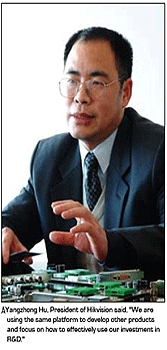
Hikvision was listed on Forbes 2006/2007 "Top 100 Chinese Firms with the Most Potential" as well as Deloitte's 2005/2006 "Top 50 Fast Growing High-Tech Firms" in China. Sales of standalone DVRs and A/V compression cards are ahead of other Chinese manufacturers.
Originally, Hikvision was a research institute, and this laid a solid foundation for its R&D capability. In 2006, Hikvision and Texas Instruments co-established a DSP laboratorya landmark in Hikvision's corporate development. Based on TI's DaVinci platform, Hikvision developed diverse products with MPEG-4 and H.264 compression, such as standalone DVRs, A/V compression cards, video servers and IP modulesthe latter are used in cameras and speed domes to make them IP-enabled. Recently, Hikvision has added IP storage devices and management software to its product mix. Hikvision receives more TI chip sets annually than any other TI partner.
Using one single platform to develop products has reduced the time and cost that it takes to develop new products. "We are using the same platform to develop other products and focus on how to effectively use our investment in R&D," said Yangzhong Hu, President of Hikvision.
Hikvision serves mainly middle to high-end markets, though it is also planning to launch entry level products, such as four-channel, standalone DVRs. Then, it will have a complete product range all the way from the low to high end. In all, the company will focus on edge products, cameras, video servers and storage devices (DVRs and IP storage). "After we complete the product lines for IP video surveillance, our next step is to strengthen our overseas marketing and sales team," said Hu. "Eventually, we expect a 50-50 breakdown in sales (domestic vs. export) in three years."
Dahua
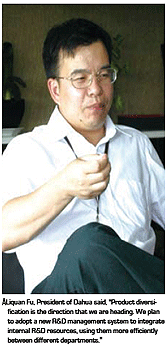
Dahua sales of standalone DVRs and capture cards are also among the top three of Chinese manufacturers. In April 2007, Dahua was listed among the Top 100 Chinese Software Companies, based on its income from software. Last year, Dahua moved up 26 places to No. 46 on the list. Dahua also invests heavily in R&D. In total, it has more than 300 people on its R&D teamengineers account for 52 percent. In the entire Chinese DVR industry, Dahau has the biggest investment for R&D.
The company provides a full array of video surveillance products, including embedded DVRs, capture cards, mobile DVRs, speed domes, network cameras, IP storage devices, video servers, IP modules and central management software.
"The security industry has become very competitive due to the entrance of IT players," said Liquan Fu, President of Dahua. "IP network solution providers, telecommunication companies and Internet service providers (ISP) are all involved in the security business. We can no longer offer just one or two product lines, such as only DVRs."
Now, 80 percent of Dahua's business involves security. In the future, it hopes to become a pure security player, focusing on video surveillance, while integrating its R&D and sales teams as well as marketing and sales channels. "Product diversification is the direction that we are heading," said Fu. Recently, the company plans to adopt a new R&D management system to integrate internal R&D resources, using them more efficiently between different departments.
Dahua also sees IP cameras and domes as security products that have the greatest potential. "The technology used in IP cameras is maturing, CMOS performance has improved a lot and prices are dropping," said Fu. "The timing is right for Chinese manufacturers to enter the market."
The enterprise has already launched several IP cameras. By manufacturing IP cameras, it is able to partner with more software developers and IP storage vendors. "Security markets have multiple layers," said Fu, "involving many hardware and software manufacturers, distributors and system integrators. We pay special attention to our partnerships with other vendors and aim to develop more value-added products to create high profit margins for our partners."
Dali
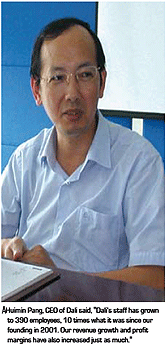
Another leading Chinese DVR manufacturer, Dali, also started out as a research institute and was the former Zhejiang Testing Technology Institute. Unlike other security companies, Dali has two main productsinfrared thermal imaging cameras and MPEG-4/H.264 DVRs. In fact, Dali has the largest market share of the former in China. In 2007, these products accounted for 50 percent of total revenue each.
The surveillance camera market will see dramatic changes due to maturing IP camera technology and dropping prices. As more software players enter the security market, Dali will manufacture products in areas where it has expertise like infrared. "While infrared has been mostly for military applications," said Huimin Pang, CEO of Dali, "infrared surveillance cameras are becoming very popular in the security industry. In fact, security has the second largest demand for infrared right now." Pang also expects use of infrared will increase in security and defense industry.
In terms of DVR manufacturing, Dali carefully selects components and designs main board layout and quality control in every single step of manufacturing. Dali even has surface mount technology (SMT) machines to do the assembling of main boards for DVRs. It also provides customization to a high degree. In addition, by following comprehensive factory management principles, stringent quality control standards are ensured. It ensures that stringent quality control standards are met. "These measures, however, naturally price it out of certain low-end markets. Meanwhile, in terms of marketing and sales, the increase of overseas market investment, of course, is Dali's latest plan."
IP Video Surveillance Platforms
While the shift to IP is perceptible, no one is sure when it will finally replace analog. China's Safe City projects require IP network transmission and this is pushing many players to launch solutions for video surveillance that, unlike overseas players, use fiber-optics to transmit uncompressed video. Quality of video is ensured by adapting to different bandwidths in different areas.
H3C
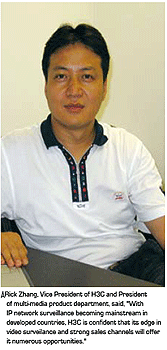
H3C is a leading China-based supplier of IP network products and solutions. Offerings include routers, ethernet switches, wireless LAN, security, voice and video over IP products, SOHO products and network management systems. H3C used to be owned by Huawei, a telecommunication networks provider before being sold to 3COM in 2006. Recently, H3C launched its iVS (IP video surveillance) solution.
The H3C iVS video surveillance solution replaces analog optical transfer devices and control matrices with IP network devices. The system features open-standard architecture and intelligent management that is applicable to large, dense surveillance projects that require high-quality images. The H3C iVS surveillance solution, which has already been deployed in Fushun City, Futian District, Shenzhen City and the Beijing Olympic transportation system, etc. won the 2006 China CIO (China Information Organization) Annual Award.
As an innovative IP-based network architecture solution provider, H3C introduces some new ideas and technologies into video survillance. For example, H3C was also the first to adopt the ethernet Passive Optical Network (EPON) technoloy in video surveillance. This solution uses passive optical splitters to evenly split a single optical input into multiple optical outputs. This function is required when a single optical pre-amplifier is used to drive a large number of optical power amplifiers.
With IP network surveillance becoming mainstream in developed countries, H3C is confident that its edge in video surveillance and strong sales channels will offer it numerous opportunities. To further its aims, it looks to partner with traditional security companies, while becoming a leading IP video surveillance solution provider.
Zhongwei (Obtelecom]
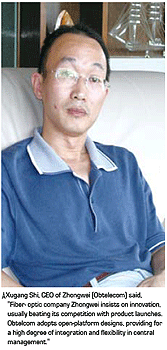
Zhongwei (Obtelecom), which specializes in fiber-optic communications, was established by a group of professors from Zhejiang University of Technology. Moreover, Zhejiang Public Fiber-optic Communication Technology Research and Development Laboratory is also managed by these professors. In 2000, the company first launched fiber-optic products for uncompressed video streaming in China. In 2001, Zhongwei developed all-in-one transmission products that integrated IP networks, Ethernet and telecommunications. "Since 1998," said CEO, Xugang Shi, "we have been promoting IP networks for security even though, at that time, very few players talked about IP. It was only in 2000 that many players started entering the market." Unlike its competitors, Zhongwei transmits uncompressed video. They, said Shi, put the emphasis on decoding technology, but that compromises video quality.
Fiber-optic company Zhongwei insists on innovation, usually beating its competition with product launches. It also develops "EPON" solutions with one foreign company. Compared with other solutions, Zhongwei adopts open-platform designs, providing for a high degree of integration and flexibility in central management. Recently, Zhongwei launched its VideoAnyRoute (VAR) transmission system, which supports transmission in all digital video formats (uncompressed digital video, MPEG-2, MPEG-4 and H.264). This replaced traditional converters, making IP network transmission more standardized and central management more flexible. The solution has been used in many Safe City projects. "Different areas of China have different bandwidths and we are trying to connect all the video through different networks. Therefore, the integration and flexibility of our solution is very important."
Software Developers
The Zhejiang provincial government has set out strategies to develop software technology. Part of this effort involves supporting university research.
Skyvision
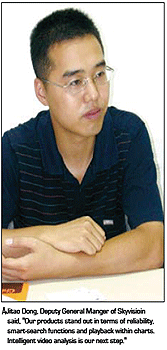
Skyvision is one of the biggest software developer of H.264 capture cards for PC-based DVR, video server, IP camera and standalone DVR in China.The company was just acquired by CSST Group this year, becoming the companyˇs software development center. Skyvision focuses on digital video surveillance software used in DVRs for recording, PTZ control and alarm management. "Our products stand out in terms of reliability, smart-search functions and playback within charts," said Jitao Dong, Deputy General Manger of Skyvisioin. "Intelligent video analysis is our next step."
The companyˇs founder also used to participate in the research institute in Zhejiang. Participation in numerous Safe Cities projects gave Skyvision the ability to design a universal user interface for capture cards and standalone DVRs, even those from different manufacturers. With regard to the important role that central management software plays in the security system, the company has also stressed development of management software, customizing it to different market sectors.
Skyvision also co-works with the Zhejiang laboratory of the application software for Safe Cities project. "Chinese government projects, like Safe Cities," said Dong, "have special standards. Skyvision is responsible for testing software to verify whether the equipment used complies with those standards."
Miaxis
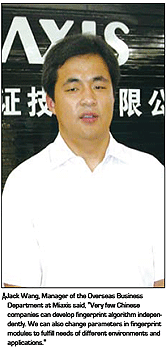
Miaxis is one of the few Chinese companies that focus on research and development of fingerprint algorithms. Main fingerprint products include verification modules (optical, electric and capacitive), readers, smartcard verification terminals, USB flashes, Ukey, mouse products, etc. It also offers bank teller identity fingerprint management system solutions, bank escort fingerprint management solutions, fingerprint door lock solutions, fingerprint safe solutions, fingerprint access control solutions, etc.
When Miaxis was established, it attracted investors from not only China but also overseas, such as Intel, Shanghai Belling, etc. Miaxis' core technology is its algorithms. "Very few Chinese companies can develop fingerprint algorithm independently," said Jack Wang, Manager of the Overseas Business Department at Miaxis. "Since 2000, the Hangzhou city government has provided us with financial support to encourage our software research as well."
Miaxis was the first Chinese manufacturer to produce embedded fingerprint modules by using DSP chipsets. Its products have been used by the Brazilian government and Nigerian governments. It is also one of the Chinese members of the BioAPI Consortium, which advocates establishment of fingerprint standards. Miaxis is the only Chinese company that participates in Fingerprint Verification Competition (FVC) and ranked among the top 10 continuously since 2000. In addition, its fingerprint algorithms have received tens of patents in China and USA.
Miaxis also highlighted their service of customization. "We can also change parameters in fingerprint modules to fulfill needs of different environments and applications," said Wang. Miaxis also predicted the high popularity of using fingerprint in PC device, such as fingerprint USB flash, fingerprint mouse. Miaxis is planning to sell those products in some wholesale stores to end users.
Solution Providers
Reformer
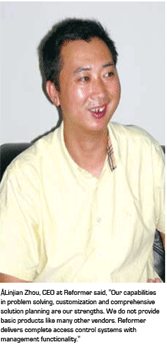
Reformer has been providing smartcard solutions for campuses in China since 1993. One card can, therefore, be used to access buildings, borrow books from the library and eat meals in the cafeteria. In 2002, Reformer began focusing on access control for the security industry.
"Reformer is a solution provider for access control used in commercial high rises, parking lots, residential communities, hospitals and shopping malls," said CEO Linjian Zhou. In fact, the company has supplied front door access control system for The People's Government of Tianjin City, systems for parking lots at The People's Government of Beijing City, as well as devices for visitors in Shanghai's Park Place, which adopting very strict security criteria as Taiwan 101 building. The technology know-how and requirements toward security are quite different and complicated in these two buildings. "We have also embedded more intelligence into our access control systems," said Zhou.
Reformer entered the smart-card market quite early. With a strong software background from the IT field, the company has the technical ability to respond quickly to market needs. "Our capabilities in problem solving, customization and comprehensive solution planning are our strengths," said Zhou. "We do not provide basic products like many other vendors. Reformer delivers complete access control systems with management functionality." In addition, Reformer is one of the few Chinese companies willing to put much investment for a unique product design.
As the Chinese smart-card market is getting saturated, Reformer's next step is to increase exports and strengthen integration of existent sales channels.
Open Design
Pearmain
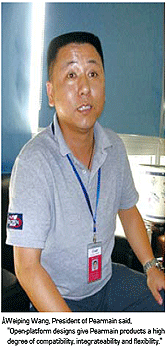
Established in 1996, Pearmain's main products are matrix, speed dome and fiber-optic converter. "Analog products will still exist in some markets," explained Weiping Wang, President of Pearmain, "no matter how much IP influences the security industry. That is why we are keeping some analog products, even though our main focus is also on developing IP products, such as those with fiber-optics."
Open-platform designs give Pearmain products a high degree of compatibility, integrateability and flexibility. "Our partners," said Wang, "often encounter problems because of the number of different formats used by different products during system integration. Our products- -cameras, matrices and fiber-optic convertersare all components of one video surveillance system, so I think when they all are included into one solution, they needs to work perfectly with other brand's products."
System integrators, who buy Permain matrices and fiberoptic converters, can easily integrate them with storage devices from other companies. Moreover, Pearmain speed domes work with any brand of camera module.
However, for many of our competitors, their products tend to be closed; not open to other products. Once the systems integrators use their products; they need to use all the products from the same vendor. "It is like the single-vendor approach, taken by our competitors, but ours is taking a multi-vendor approach," said Wang.
Final Words
Zhejiang gathers many excellent and visionary security players in one place. Regarding their technological capabilities, they have no problems facing worldwide competition and meeting strict requirements of quality. However, more importantly, Zhejiang vendors need to think about how to integrate their strong R&D capability with effective marketing and sales to market their products to the world